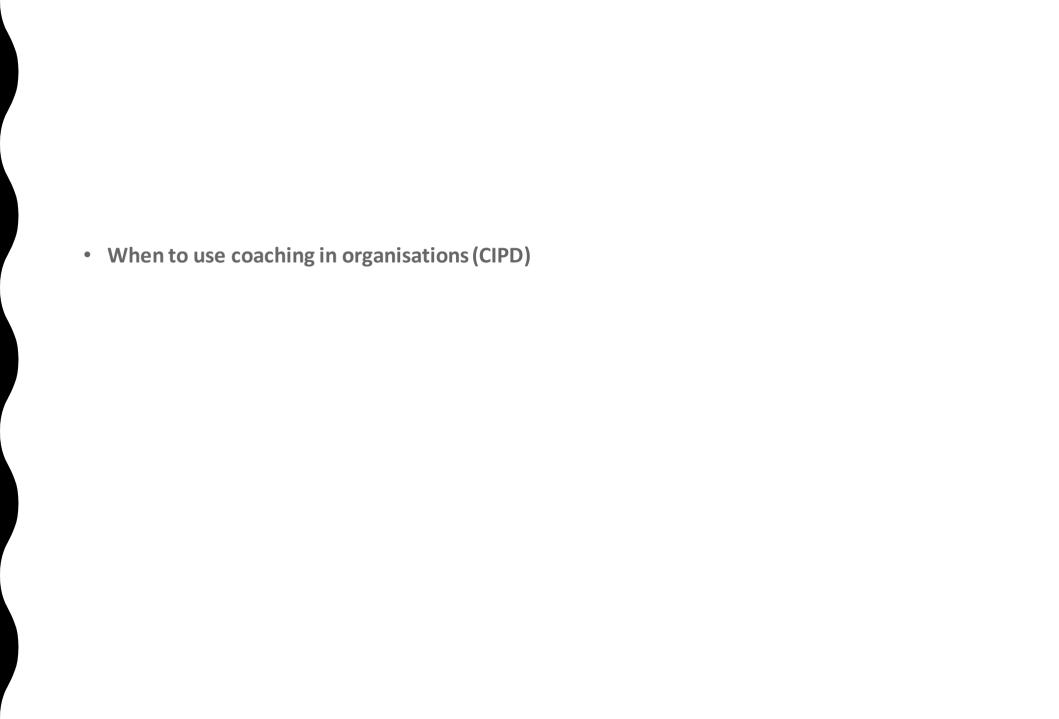
2 minute read
Assessment Criteria AC 1.2 Demonstrate
how the relationship between individual, team and departmental performance development links to coaching
Best Practice for AC 1.2
Advertisement
All assessment criteria must be addressed as individual pieces of evidence
1.2 & 1.3 Readily co-joined with the narrative above as a sustained piece, once the relationship between individual performance and contribution to the achievement of team, departmental and organisational goals is established then, the rationale for coaching and mentoring as a performance improvement/development approach can be readily made. Certain of these criteria identify coaching and mentoring separately such that candidates will need to make distinctions in the context of their responses based on the differences between these disciplines
Assessment
Criteria AC 1 .3
Demonstrate how the relationship between individual, team and departmental performance development links to mentoring
Best Practice for AC 1.3
All assessment criteria must be addressed as individual pieces of evidence
1.2 & 1.3 Readily co-joined with the narrative above as a sustained piece, once the relationship between individual performance and contribution to the achievement of team, departmental and organisational goals is established then, the rationale for coaching and mentoring as a performance improvement/development approach can be readily made.
Certain of these criteria identify coaching and mentoring separately such that candidates will need to make distinctions in the context of their responses based on the differences between these disciplines
Assessment Criteria AC 1.4 Develop a case that coaching and mentoring can benefit organisational strategic performance objectives through individual, team and departmental performance development
All assessment criteria must be addressed as individual pieces of evidence
Best Practice for AC 1.4
It may be useful to outline some of the benefits of coaching and mentoring in supporting performance improvement/development and the achievement of objectives for individuals, teams and departments.
Learners, where possible, should integrate the characteristics of their own organisation into this narrative in order to demonstrate the potential for coaching and mentoring to drive organisational performance and development in context.
Areas that may be of relevance to consider here include (but are not confined to) the following:
• Coaching and mentoring acts as an enabler at the individual level to create a sustained development opportunity for that individual. The potential value of this would be that the individual’s development could be more rounded, contextualised, personalised and, potentially better assimilated resulting in enhanced performance and development overall
Assessment Criteria AC 1.4 Develop a case that coaching and mentoring can benefit organisational strategic performance objectives through individual, team and departmental performance development
All assessment criteria must be addressed as individual pieces of evidence
Best Practice for AC 1.4
• Coaching and mentoring promotes communications, developmental, and cultural impacts resulting from collaboration, relationship building, trust, respect, support, formalising informal networks, disseminating good practice, connectivity etc
• Coaching and mentoring allows more staff to become involved in leadership and organisational development (distributed leadership, distributed learning opportunities)
• Coaching and mentoring leverages experience and knowledge; sharing personal and professional growth and development (both ways: mentor/coach and mentee/coachee). Assists organisations when preparing for succession.
• Establishing the key principles of coaching i.e. awareness and responsibility, supports opportunities for effective change management, individual, group and organisational development
Assessment Criteria AC 1.5 Conduct a cost/benefit analysis of a coaching and mentoring process to support achievement of organisational strategic performance objectives.
All assessment criteria must be addressed as individual pieces of evidence
Best Practice for AC 1.5
In constructing a cost and benefit analysis that demonstrates the achievement of organisational strategic performance indicators, Learners may or may not be able to access relevant specific financial information.
If the latter is the case it would still be appropriate for the Learner to identify ‘areas’ of cost and benefit in order that this criteria might be addressed; some examples are listed below but, where possible, these should be linked to the Learner’s own organisational setting.







